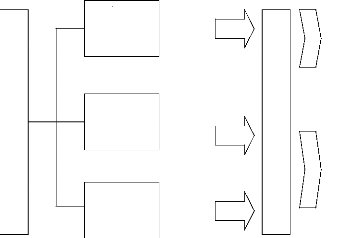Chapter 4
TOURISM AND INFORMATION TECHNOLOGY
DEMAND TRENDS AND INFORMATION TECHNOLOGY
ITs are not new to tourism industry. Computerized networks, and
particularly airline Computer Reservation Systems (CRSs) have been leading
dramatic changes since the early 1 970's. Airlines realized that their presence
through interfaces on travel agencies desktop was critical to attract booking
and manage their inventory and capacity distribution. The evolution of CRSs to
Global Distribution Systems (GDSs) in the early 1980's developed the first
electronic marketplace by integrating other airlines' reservation systems as
well as providing booking access to a range of tourism products from hotel to
car rentals. However the traditional CRS/GDS had only improved the information
communications between tourism businesses such as airlines and travel agents,
as they do not interact directly with the consumer. The systems are also
expensive to both the tourism producer and the retailer. Moreover these systems
are flawed with incompatibilities between each other, especially in the lodging
sector where «switch» companies such as THISCO (The Hotel Industry
Switching Company) was needed to connect hotels with majors GDSs, to facilitate
room reservations
for travel agents worldwide (Liu, 2000). But one should keep in
mind that GDSs are the backbone of the electronic distribution system of the
travel industry.
Information Technologies' (ITs) rapid developments in the 1990s
are now having profound impacts and implications for the whole tourism
industry. Beside the macroeconomic level where ITs are regarded as instrumental
in regional development, long term pro sperity, new information society and
knowledge-based economic powers (Buhalis, 1996), tourism is inevitably
influenced by the business re-engineering experience that this revolution had
provide (WTO, 1998). As information is the life-blood of the travel industry
(Sheldon, 1997), effective use of technology is fundamental to the tourism
sector. The most pro found impact of ITs on tourism management is efficiency in
cooperation among the industry's actors and the availability of tools for a
real globalization of the industry. It changes the best operation practices and
provides opportunities for business expansion in the geographical, marketing
and operational sense (Buhalis, 2000). As a result ITs facilitate the
integration of the industry in both geographical and operational terms.
(expansion to new productdestinations and vertical integration). Consequently,
tourism destinations must compete in a fiercely competitive marketplace; thus,
ITs have become a critical factor in determining future success or failure, as
well as tourism impacts at destinations. In fact ITs can empower promotion's
management and distributions of product-destination through the development of
Destination Marketing Systems (Buhalis, 1997).
Destinations increasingly attract international tourism from
distant and long haul markets, making information dissemination more imperative
than ever. Outbound markets are characterized by short gateways breaks with
trip decisions made on impulse from previous trips shortly before departures.
Therefore, the international tourist put emphasis on speed and information's
availability and accuracy as well as efficient reservation facilities. He is
increasingly more sophisticated and «wired». Consequently the rapid
development of both tourism supply and demand makes ITs an imperative partners
of the industry and thus ITs ever more play an important role in tourism
marketing, distribution, promotion and co-ordination (Buhalis and Spada, 2000).
Efficiency, speed and flexibility in responding to consumer requirements and
needs are now becoming a core competency in tourism marketing. ITs tools now
facilitate mass customization of tourism products. Complex and flexible bundles
of tourism offering can be configured. Furthermore ITs' based knowledge
management tools enable individualized marketing to customers (Werthner and
Klein, 1999).
Hence tourism organizations should develop partnerships aimed to
improve business processes using ITs, which will enhance the quality of their
interactions with their stakeholders from the producer to the supplier to the
consumer. The challenge for the industry is to provide a seamless integration
of information and physical service, with flexible configurations of the
physical and the information parts. Destinations that provide timely,
appropriate and accurate information, using ITs tools, to consumers and the
travel trade, have a better
chance of being selected and of strengthening their
competitiveness (Buhalis, Spada, 2000).
Today the development of the Internet revolutionized the usage of
ITs by providing the infrastructure of intra and inter-organization networking
between all computer users. The problem of GDSs incompatibility can now be
addressed effectively and cheaply. In addition a web base GDS has improved the
quality of information delivery (window based computer screen) and is
accessible instantly worldwide at a cheaper cost. The Internet tool enabled
instant distribution of rich media colorful content, booking capabilities and
e-commerce platforms to conduct online business. It offers substantial
advantages in communications, market research, market targeting, costumer
services, product development, cost savings and product delivering. Today, the
Internet is widely recognized as an extremely valuable marketing tool.

Inside organization
Between organizations
Between organization and clients
LAN Org.
MIS
C RS/GDS
Web page
W
W
W
System
I T
Coop. System
Figure 2. The deployment of IT in Tourism (With ref. to Shertler
W., 1990).
| 

